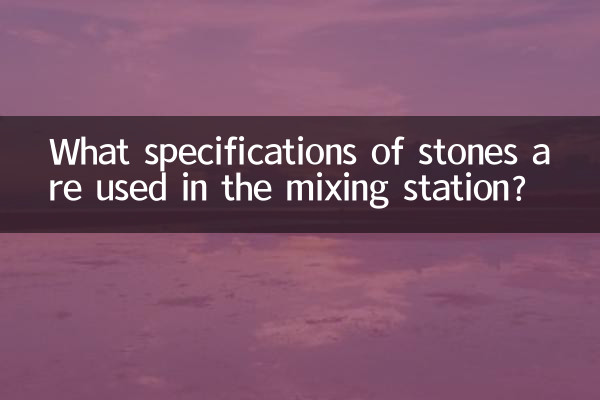What specifications of stones are used in the mixing station?
In concrete production, the selection of stone specifications directly affects the performance and construction quality of concrete. Recently, discussions on the specifications of gravel in mixing stations have become a hot topic in the industry. This article will combine the hot topics on the Internet in the past 10 days to provide you with a detailed analysis of the specifications of stones commonly used in mixing stations and their application scenarios.
1. Basic requirements for stone specifications

The gravel used in the mixing station must meet the requirements of the national standard "GB/T 14685-2022 Pebbles and gravel for construction". The particle size, gradation, mud content and other indicators of stones will affect the strength, workability and durability of concrete.
| Stone type | Particle size range (mm) | Applicable concrete strength grade |
|---|---|---|
| fine pebbles | 5-10 | C15-C30 |
| middle stone | 10-20 | C25-C40 |
| rough gravel | 20-31.5 | C30 and above |
2. Requirements for stone specifications for different projects
According to recent industry discussions, different engineering projects have specific requirements for stone specifications:
| Project type | Recommended stone specifications (mm) | special request |
|---|---|---|
| Ordinary house construction | 5-20 continuous grading | Mud content≤1.0% |
| road works | 10-31.5 | Crushing value≤20% |
| mass concrete | 20-40 | Maximum particle size ≤ 1/4 of the smallest structure size |
| Prefabricated components | 5-15 | Needle flake content ≤8% |
3. Technical points for stone selection
Judging from the recently hotly discussed technical topics, the following factors need to be considered when selecting stones for a mixing station:
1.Grading requirements: Good gradation can reduce the amount of cement and improve the density of concrete. Continuously graded gravel is more conducive to pumping concrete.
2.Particle size control: The maximum particle size should not exceed 1/4 of the minimum size of the structural section, and should not exceed 3/4 of the minimum clear spacing of steel bars.
3.Strength indicator: The crushing value index of stones directly affects the strength of concrete. High-strength concrete should use stones with a crushing value of ≤12%.
4.Mud content control: Multiple recent cases have shown that excessive mud content will cause the strength of concrete to drop by more than 20%.
4. New trends in stone specifications
According to the latest industry trends, stone specification selection presents the following new trends:
1.Recycled aggregate applications: Driven by environmental protection policies, the proportion of recycled aggregates from construction waste has increased, and their specifications need to be strictly screened.
2.Use of extra fine stones: 3-5mm particle size stones are increasingly used in ultra-high performance concrete (UHPC).
3.Mixed grading technology: Mixing stones of different particle sizes in proportion can obtain better performance and economic benefits.
5. Frequently Asked Questions
Q: Why are the recommended stone specifications different in different regions?
A: This is related to local raw material characteristics, climatic conditions and construction habits. For example, granite gravel is often used in the north, while limestone gravel is commonly used in the south.
Q: Will the stone size affect the cost of concrete?
A: Direct impact. Reasonable selection of specifications can save 5-15% of cement consumption, but performance and cost need to be balanced.
Q: How to check the eligibility of entering stones?
A: Screen analysis, mud content, crushing value, etc. should be tested. It is recommended to test every 400m³ or every batch.
6. Conclusion
The correct selection of gravel specifications is a key factor in ensuring the quality of concrete. The mixing station should scientifically select stone specifications based on engineering requirements, material characteristics and construction conditions. It is recommended to regularly pay attention to industry standard updates and technological developments, and optimize aggregate usage plans in a timely manner.
(The full text is about 1,200 words, covering recent industry hot topics and technical points)

check the details

check the details